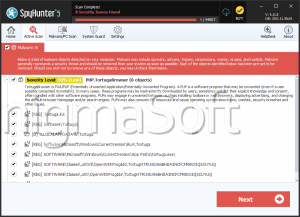TUGA Ransomware
The TUGA Ransomware is a threatening tool specializing in file encryption, rendering the victim's data inaccessible. This ransomware variant employs a distinctive technique by appending the specific '.TUGA' extension to the original filenames. Additionally, TUGA leaves behind a ransom note in the form of a text file named 'README.txt.' An example of TUGA's file renaming strategy includes transforming files such as '1.png' into '2.png.TUGA' and '2.pdf' into '2.pdf.TUGA,' further emphasizing its ruthless effectiveness.
Ransomware Threats Like TUGA Extort Their Victims for Money
However, paying the ransom is strongly discouraged due to several reasons. Firstly, it only serves to incentivize cybercriminals to persist in their illegal activities, encouraging further attacks on unsuspecting victims. Moreover, paying the ransom may not result in the successful recovery of the files. Ransomware, such as TUGA, operates as a malicious form of malware that can potentially lead to further encryption and infections, exacerbating the damage caused to the compromised systems.
The TUGA Ransomware employs a comprehensive strategy to inform its victims about the compromise of their systems through a dedicated ransom note. This note also provides a means of communication with the hackers through a link to the Telegram channel 't.me/hell2cat.' The attackers demand a ransom payment of $1000 in exchange for the crucial decryption key, which is required to regain access to the locked files. It is crucial to note that attempting to restore the encrypted files without possessing the specific decryption tools held by the attackers is typically an impossible task.
In order to mitigate the impact of such threats, it is imperative for victims to take immediate action and remove the ransomware from the infected systems as soon as possible. Swiftly addressing the presence of ransomware can help prevent further data loss, mitigate potential risks, and provide an opportunity to explore alternative methods of file recovery that do not involve negotiating with cybercriminals.
Implement Robust Security Measures against Ransomware Threats
Protecting devices and data from ransomware threats requires a combination of proactive measures and cautious online behavior. Here are several key steps users can take to enhance their defenses:
- Maintain up-to-date software: Regularly update operating systems, applications, and security software on all devices. Updates often include patches to fix vulnerabilities that can be exploited by ransomware.
- Install reputable anti-malware software: Use reliable security software that offers real-time protection against ransomware and other malware threats. Keep the software updated to ensure optimal effectiveness.
- Exercise caution with email attachments and links: Be vigilant when accessing links or opening email attachments , especially from unfamiliar or suspicious senders. Avoid downloading attachments or clicking on links unless they are verified as safe.
- Backup important data: Regularly back up all essential files and data to an independent storage device or a secure cloud service. Ensure backups are automated and stored offline or in a separate network location to prevent them from being compromised.
- Exercise caution when downloading software: Obtain software only from official and reputable sources. Avoid downloading software from untrusted websites or third-party sources, as they may include malicious payloads.
- Keep yourself informed and educate your employees: Stay informed about current ransomware trends, techniques, and prevention strategies. Educate yourself and your employees about the risks associated with ransomware, emphasizing the importance of cautious online behavior.
By adopting these preventative measures, users can significantly reduce their vulnerability to ransomware threats and safeguard their devices and valuable data. Regularly updating security measures and staying vigilant are essential components of a robust defense against evolving ransomware attacks.
The text of the ransom note delivered to the victims of the TUGA Ransomware is:
'You've been hacked
t.me/hell2cat
Pay me 1000$ and I'll give you the decryption key!
Or you will join a terrorist network list :C'


